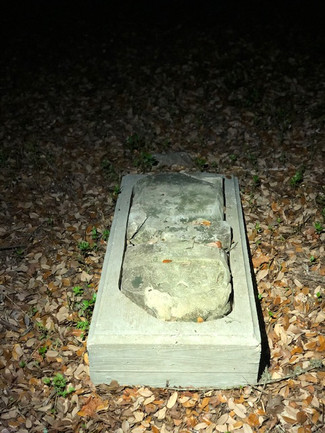FADEOUT
- RPA
- May 29, 2021
- 5 min read
Updated: Jun 1, 2021
Light of day dims when you’re off-guard and begins its fadeout like a silent film. On those days, I feel heavier, unenthused, but resolute to rescue the day I’m losing to tablets, Amazon, and my little black hole: my couch, where I doze off, my cell phone slipping out of my hand.
It was on a day like this we would steal a hike, the sun quickly slipping into the horizon. We had an hour of daylight. Tops. We hopped in the car and made our way to Mary Moore Searight Metropolitan Park. We headed down the long entrance to the main parking lot, passing an airfield for remote control airplanes on the east side of the entrance. We saw a beautiful red and white plane shoot above the treeline, stall, and dive out of sight. We made it to the parking lot, and as usual here, noticed several people just sitting in their cars with the engines running.
The sky was heavy with slush-grey clouds, a herd of jostling elephants. I wanted to start as soon as we could. We walked up to the kiosk by the trailhead. I wanted to see if there was a map. Maybe I’ve overlooked a trail or a sight, even though I’ve been here countless times. When we got to the kiosk, there was no map. The plastic was discolored and cracked. Dilapidated. It hadn’t been attended to in years. It made me sad, not because it was old, but because this place just feels forgotten. Mary Searight Moore was a rancher who moved here with her father when he was a Texas Supreme Court Justice. She sold 88 acres to the city of Austin, and donated over 200 more. She turned down millions to preserve the land for the public. I can just imagine the Real Estate developers circling around her like agents from the Matrix, frustrated by this Morpheus and her Zion, in South Austin, the rebel who would not take the pill.
I led my family on the hike, only to feel like I was in an old garden beset with weeds, the crops ravishly dug up, the soil dry and filled with rocks. Does a city know its wild places? Her family bought this land from THE Slaughters, contemporaries of Stephen F. Austin, in the 1830s. This isn’t just a city park. It’s our wild place in the city.
Just past the trailhead, we were about to cross a rockbed, but I noticed what was perhaps a natural trail running along the bank of the creek. Not one to always color in between the lines, I hopped over the water from rock to rock until I got to the bank which was covered with copper leaves that looked like a treasure of pennies spread over the ground. My son was able to find a tree to climb in. A wild place. I watched as he smiled with wide open eyes. I felt like I was in a cave of grey branches, blotched with patches of emerald green. We could make out a trail and we continued, in that wonderful tension of excitement for the unknown, and the apprehension of my suburban, programmed mind. You begin your real hike when
you know you’ve successfully ripped off that programming like an old garment, and your surroundings begin to crackle with wild energy.
My wife stood below the trees, the boughs bending down to her like horses for water, the leaves glowing like Kryptonite against the grey. We continued down the trail, giddy, with no map, and entered into a clearing on top of a large rockbed by a street bridge. We got to see the graffitti of “TWIG” and other artists marking concrete with all of the lava of youth gushing from within them. We crawled under the storm drain and found some hieroglyphs of middle-fingers for the audience. I let out a belly laugh with my head tilted back.
We set off down the street and noticed the greenbelt wrapped in barbed wire. That always sticks in my craw, but when I saw the sign, I was relieved. This area was the David Moore Wildlife Sanctuary. Redbirds and bluebirds zipped and flashed happily across the bush, busy as a beehive. We were now outside the park, and we could see a neighborhood of homes. We took a dirt road by the sanctuary away from the neighborhood, and walked down until we dead-ended. We passed several hidden homes set on large tracts of land. We could make out a secret entrance to a trail ahead by some trees.
We entered a great canopy of Live Oaks that were taller and older, and stretched over us like centuries. Rain drip-dropped on our skin through the trees for just a moment, and we saw a father hiking with his young son in front of him, holding him by the hands, like a toddler learning to walk.
We found our way back to the heart of the park and decided to walk a lap on the concrete loop to get in some more miles. The concrete was cracked and broken, revealing the gravel and earth below. The woods were now very dark, the trees silhouettes against the lights of the city, lighting up the sky orange and azure, and finally fading out with charcoal hues. We passed park benches that were plated with memorials for unknown souls. I thought of the loved ones who must have stood here, mumbling with grief, hats in hands, sobbing with trembling chests.
We circled back to the trail and I told them we should look for the cemetery of the Slaughter family that I read was hidden in a subdivision just by the park. My son, of course, was excited to search for the place, as was I. I looked up the details and the approximate location, and we headed out. We walked by the long road entrance and began to come across some sketchy water crossings. My son wanted to see if he could find a shortcut across a flooded sidewalk. He tiptoed on the grass, squishing the mud with his shoes, looking for the driest spots. He stepped onto the sidewalk to test it, and WHAM, he slipped onto his side, doing a half- cartwheel onto the muddy concrete. He was dazed by the impact but giggled and grimaced with pain at his costly footstep scouting a path for the team. My
wife sprayed water from her bottle over his hands to help him get the mud off. We all laughed at the gamble because the judgement was swift, but we’ve ALL been there before…
We found a trail that led to the subdivision and we walked by all the fabricated homes. Houses all shades of the same color. My son’s tennis shoes made wet, smacking sounds on the street behind us. By the mailboxes, up ahead, we saw a grove of trees and a small plot of land with a high iron fence around it. I reminded my son to respect the dead, and he looked up at me in the moonlight, solemnly.
We turned on our flashlights and saw the old stones. The headstones were laid flat in concrete encasements because they had fallen apart. If you looked closely, you could make out the name SLAUGHTER on one of them. This was the grave of Captain Augustus Slaughter. He fought in the Civil War for the Union and was laid to rest here in 1866. I got to tell my son that he was buried here during the time of Abraham Lincoln. My son stood, quietly, his mind busy with wonder at the dead.
We made our way back to the parking lot and came across some deer in a meadow huddled in the grass. They batted their silver-blue eyes and stood still, ready for flight. A bobbing light behind us approached closer and closer. A night jogger passed, and we continued to our car. When we reached the parking lot, several cars were parked, engines running, with lights off and passengers inside. They stared down at their phones like sitting statues, their faces glowing in the night.























































Comments